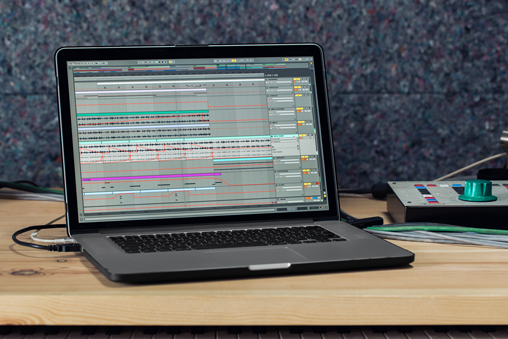How to Master a Track in Ableton Live

In this article, we’ll explore the world of Ableton Live, a popular software used by musicians and producers worldwide. We’ll dive into the key features of Ableton Live, including the Session and Arrangement views, audio and MIDI effects, and instruments.
We’ll also discuss the importance of mastering in music production and provide step-by-step instructions on how to master a track using Ableton Live. We’ll share some valuable tips to help you achieve professional-sounding results. Let’s get started!
How to Master a Track in Ableton Live: Key Takeaways:
- Mastering a track in Ableton Live involves balancing levels, using effects, and finalising the master.
- Using quality plugins and referencing tracks can help improve the mastering process in Ableton Live.
- Take breaks and experiment with multiple mastering chains to achieve the best possible sound for your track.
What Is Ableton Live?
Ableton Live is a powerful software used for music production, live performance, and DJing, developed by Ableton AG.
One of the most notable features of Ableton Live is its intuitive interface, which allows users to seamlessly arrange, mix, and manipulate audio and MIDI clips. The software’s session view enables performers to trigger loops, samples, and effects in real-time, making it ideal for live settings and improvisational performances.
Furthermore, Ableton Live offers a wide range of instruments, effects, and tools that cater to the diverse needs of music producers and performers. Its advanced MIDI capabilities, automation features, and audio recording functionalities make it a go-to choice for professionals in the industry.
What Are the Key Features of Ableton Live?
Ableton Live offers a comprehensive set of features for music production, including:
- Track editing
- Mixing tools
- EQ effects
- Compression options
- A wide range of plug-ins
- Mastering capabilities
Session View
The Session View in Ableton Live provides a non-linear approach to music creation, allowing users to improvise, experiment with arrangements, and trigger different clips and loops in real-time.
By utilising the Session View’s grid layout, musicians can easily organise and trigger individual clips, loops, or entire song sections. This feature promotes a fluid and dynamic workflow, enabling users to test different musical ideas, transitions, and combinations effortlessly. The ability to seamlessly switch between various clips and scenes fosters spontaneity and creativity during performances or studio sessions. The Session View’s session recording functionality captures every musical idea, making it perfect for live performances or later refinement in the Arrangement View.
Arrangement View
The Arrangement View in Ableton Live offers a traditional linear timeline for detailed music arrangement, editing, and fine-tuning of tracks, providing a structured layout for precise control over composition.
It serves as the backbone of the music production process, allowing users to sequence and organise their ideas effortlessly. With the ability to arrange clips, loops, and audio tracks in a logical order, musicians can build and sculpt their songs with ease. The Arrangement View fosters a fluid workflow, enabling seamless transitions between different sections of a track.
Audio and MIDI Effects
Ableton Live offers a diverse array of audio effects and MIDI effects, allowing users to manipulate sounds, create unique textures, and add dynamic elements to their music productions.
Audio effects in Ableton Live can range from basic tools like EQ and compressors to more complex ones such as reverb, delay, and modulation effects like chorus and phasers. These effects play a crucial role in shaping the character of sounds, adding depth, space, and movement to tracks.
On the other hand, MIDI effects are designed to manipulate the incoming MIDI data, enabling users to generate new musical ideas and patterns, including arpeggios, chord generation, and random note generation. This flexibility opens up endless possibilities for musical exploration and experimentation in the production process.
Instruments
The Instruments in Ableton Live encompass a range of synthesizers, samplers, and virtual instruments that offer creative sound design options, expressive capabilities, and diverse musical textures for producers and performers.
One of the standout synthesizers in Ableton Live is the Operator, a versatile FM synth that enables users to craft intricate timbres and evolving textures.
The Wavetable synthesizer allows for dynamic wavetable synthesis, granting musicians the ability to create rich, evolving sounds.
In terms of samplers, the Simpler instrument provides intuitive sampling capabilities for manipulating audio clips, while the Sampler offers advanced features such as multisampling and modulation options.
What Is Mastering in Music Production?
.jpg)
Mastering in music production is the final step in the audio post-production process, where tracks are polished, balanced, and optimised to achieve a consistent sound quality, clarity, and optimal loudness levels.
Mastering involves a meticulous process that requires a trained ear to fine-tune every element of a track, including EQ adjustments, dynamic range enhancements, stereo imaging optimization, and overall tonal balance. A crucial aspect of mastering is ensuring that the track sound cohesive across different playback systems and formats. By utilising specialised software and hardware tools, audio engineers can carefully sculpt the overall sound of the music, bringing out its full potential and making it ready for distribution on various platforms.
Why Is Mastering Important?
Mastering is crucial in music production to ensure that tracks reach their full potential, sound professional, and are well-balanced for the final mix and export stages.
It is during the mastering stage that professionals apply signal processing techniques to enhance the overall sound quality, dynamics, and clarity of a song.
By carefully managing frequencies, levels, and stereo imaging, mastering engineers can bring out the best in each track, making sure it translates well across various playback systems and maintains consistency throughout an album.
What Are the Steps to Master a Track in Ableton Live?
.jpg)
Mastering a track in Ableton Live involves a series of steps: preparing the track, balancing levels and EQ, adding compression for dynamics, enhancing stereo imaging, and finalising the master for export.
Once the initial mixing is done, it’s time to focus on preparing the track for mastering in Ableton Live. This step includes ensuring a clean signal flow, setting appropriate gain levels, and organizing the tracks for efficient processing.
Balancing levels and EQ come next, where each element of the mix is fine-tuned to achieve an optimal balance and tonal quality. Applying compression for dynamics is crucial to control the overall dynamic range and ensure a consistent sound throughout the track.
Preparing the Track
Preparing the track for mastering in Ableton Live involves fine-tuning details, making adjustments, and ensuring that the audio elements are ready for the mastering process.
One crucial aspect of prepping your track in Ableton Live is ensuring that all the individual elements work harmoniously together. This involves checking the overall mix balance, adjusting levels, and focusing on the finer nuances of each element. Detail-oriented work at this stage ensures a solid foundation for the mastering engineer to work on, allowing them to enhance the track effectively. It’s essential to review the entire arrangement, making any necessary refinements to transitions, fades, and effects for optimal cohesion.
Balancing Levels and EQ
Balancing levels and EQ in Ableton Live is essential to ensure that different frequencies are properly adjusted, levels are consistent, and stereo image is well-defined for a cohesive sound.
When working on a track, making sure that each element sits right in the mix is key to creating a professional and polished sound. Mastering EQ adjustments play a crucial role in this process, allowing you to sculpt the frequency spectrum to bring out the best in each instrument or vocal. By paying attention to the frequency adjustments and ensuring that no element dominates the mix, you can achieve a harmonious blend.
Plus EQ, maintaining level consistency is vital. This involves ensuring that all elements in your mix are at suitable volume levels relative to each other, preventing any part from being too loud or too soft. Utilising tools like compressors and limiters can assist in achieving this balance.
Moreover, stereo imaging is another aspect that directly impacts the width and spatial placement of individual elements within the mix. Through careful adjustments, you can create a sense of depth and space, enhancing the overall listening experience for your audience.
Adding Compression
Adding compression in Ableton Live allows for dynamic control, intensity adjustments, and automation of volume levels to enhance the overall sound and ensure a balanced mix.
When utilising compression in your music production workflow, you can shape the transients and sustain of your audio, bringing out details that might have been previously hidden. By tweaking the threshold, ratio, attack, and release settings, you can fine-tune how intensely the compression affects your tracks, ultimately leading to a more polished and professional sound.
Applying Reverb and Delay
Applying reverb and delay effects in Ableton Live can add depth, ambiance, and character to the audio, enhancing the overall sound texture and spatial qualities of the mix.
Reverb and delay effects play a crucial role in the post-production process, creating a sense of space and dimension that can transport your listeners into a different sonic world. Utilising reverb can simulate various environments, from small rooms to vast concert halls, giving your tracks a sense of realism and depth. On the other hand, delay effects can add rhythmic patterns and repetitions, contributing to the overall groove and atmosphere of the music.
Using Limiters and Maximizers
Using limiters and maximisers in Ableton Live is essential for achieving optimal loudness levels, preventing clipping, and ensuring that the master meets the requirements of various mastering jobs.
Limiters and maximisers play a crucial role in the final stage of the mastering process in Ableton Live. While limiters help in controlling the peaks and overall loudness of the track, maximisers enhance the perceived loudness without causing distortion.
These tools are instrumental in ensuring that the master track complies with industry standards, such as those set for streaming services, broadcasting, or physical media. By carefully using limiters and maximisers, mastering engineers can fine-tune the dynamics of the audio, achieve a polished sound, and enhance the overall listening experience for audiences.
Finalising the Master
Finalising the master in Ableton Live involves fine-tuning the final mix, ensuring export readiness, and applying polishing touches to achieve a professional sound output.
Once the final mix is dialled in, it’s crucial to make thorough final mix adjustments to address any remaining inconsistencies and ensure optimum balance across all elements of the track. This involves tweaking levels, panning, and applying any necessary EQ or compression to enhance the overall sound.
In terms of export preparations, it’s essential to set the correct parameters for the final audio file. This includes selecting the appropriate file format, bit depth, and sample rate to maintain the highest quality during the export process.
After the technical aspects are in place, the next step is to focus on polishing techniques to elevate the production value of the track. This may involve adding subtle effects, automation, or mastering plugins to finesse the sound and bring it to its full potential.
What Are Some Tips for Mastering in Ableton Live?
Mastering in Ableton Live can be optimised with useful tips and tricks that streamline the workflow, enhance efficiency, and improve the quality of the final master.
One key practice is organising your tracks effectively by assigning colour codes to different elements, such as drums, synths, vocals, etc. This visual organisation can significantly speed up your workflow and make it easier to navigate through your project.
Utilising Ableton Live’s grouping feature for similar tracks can help you apply effects, adjustments, or automation to multiple tracks simultaneously, saving you precious time and maintaining consistency across your mix.
Experimenting with different audio effects and mastering plugins within Ableton Live can further enhance the overall quality of your master. Remember to A/B test your changes to ensure they are improving the sound and not detracting from it.
Use Reference Tracks
Utilising reference tracks in Ableton Live helps in comparing sound quality, understanding genre-specific characteristics, and setting benchmarks for mastering outcomes.
Reference tracks play a crucial role in shaping the final sound quality of a track during the mastering process. By incorporating reference tracks, producers and engineers gain a valuable point of comparison, allowing them to identify areas where their own mix can be improved. This practice goes beyond mere emulation; it serves as a guidepost for achieving the desired sonic results.
When diving into genre-specific characteristics, reference tracks provide a roadmap for understanding the nuances that define different music styles. This aids in tailoring the mastering process to suit the specific requirements of the genre being worked on.
Take Breaks
Taking breaks during mastering sessions in Ableton Live is crucial for ear fatigue prevention, maintaining focus, and ensuring consistent quality in the mastering process.
For music producers and audio engineers who spend hours meticulously fine-tuning tracks in Ableton Live, incorporating regular breaks is essential to sustain their energy levels and mental clarity. These pauses not only provide a much-needed rest for the ears, reducing the risk of fatigue and potential hearing damage, but also allow individuals to step back and approach their work with a fresh perspective.
Use Quality Plugins
Utilising high-quality plugins in Ableton Live enhances the mastering process, offering advanced features, precise control, and superior sound manipulation capabilities.
These quality plugins, such as Waves L3 Multimaximizer or Izotope Ozone, provide a wide range of options for sculpting and perfecting the final sound of your music. With intuitive interfaces and customisable settings, users can fine-tune every aspect of the audio, from EQ adjustments to dynamic processing.
These tools often come equipped with cutting-edge algorithms that ensure a transparent and professional result, elevating the overall quality of your music production. Whether you’re aiming for a polished finish or experimenting with creative effects, high-quality plugins can significantly augment your mastering workflow in Ableton Live.
Use Multiple Mastering Chains
Employing multiple mastering chains in Ableton Live allows for experimentation, flexibility, and future-proofing of mastering decisions, enabling diverse sound outcomes and adaptability.
By utilising various mastering chains, audio engineers can test different processing techniques and signal chains, leading to unique sonic textures and creative results. This experimentation fosters an environment that encourages innovation and pushes the boundaries of traditional mastering practices.
The flexibility offered by multiple mastering chains allows producers to swiftly adapt their sound mastering processes to suit specific tracks or genres. This adaptability ensures that the mastering approach remains versatile and can cater to a wide range of musical styles and preferences.
In terms of future-proofing mastering decisions, having multiple chains at hand allows for easy adjustments and revisions without disrupting the workflow. This foresight in planning ensures that any changes in sound trends or personal preferences can be accommodated seamlessly, keeping the mastering process relevant and up-to-date.
Frequently Asked Questions
How to Master a Track in Ableton Live
To master a track in Ableton Live, follow these steps:
- Finalise your mix and adjust the levels of each track
- Add EQ and compression to enhance the overall sound
- Add effects such as reverb or delay to create depth and space
- Use a limiter to ensure the track does not clip and to increase volume
- Export the final track as a WAV or MP3 file
What is the purpose of mastering a track in Ableton Live?
The purpose of mastering a track is to make the final mix sound polished and professional. It involves fine-tuning the levels, EQ, and dynamics of the track to achieve a cohesive and balanced sound.
Do I need any special plugins to master a track in Ableton Live?
No, Ableton Live has built-in mastering tools such as EQ, compressors, and limiters that can be used to achieve a professional sound. However, some producers may choose to use external plugins for additional processing.
Can I master a track in Ableton Live without any prior experience?
While it is recommended to have some basic knowledge of mixing and mastering techniques, Ableton Live offers a user-friendly interface and built-in tools that make it possible for beginners to master their tracks with little experience.
What are some common mistakes to avoid when mastering a track in Ableton Live?
Some common mistakes to avoid when mastering a track in Ableton Live include over-compressing, over-EQing, and not leaving enough headroom for the final track to breathe. It is also important to regularly reference the track on different speakers or headphones to ensure the mix translates well on different systems.
Is there a specific order to follow when mastering a track in Ableton Live?
While there is no set order, it is generally recommended to start with EQ and compression, followed by effects such as reverb and delay, and then finish with limiting. However, different producers may have their own preferred workflow and it ultimately depends on the individual track and desired sound.
Are you an aspiring writer, producer, engineer, artist or musician looking for the best courses for music producers? Hone your sound, explore your talent and unlock unique opportunities in music technology with Elevate’s online music production courses.
From the blog

Rockstars in Training: The Best Kids’ Electric Guitars for 2024

Redefining Your Riffs: How Electric Guitar Strings Shape Your Sound


